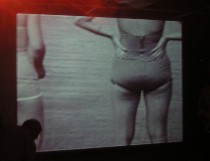 The Fabric Workshop and Museum by showing international players in the art world is not only cementing its own place in the larger scene. It’s putting Philadelphia in the larger scene as well.
The Fabric Workshop and Museum by showing international players in the art world is not only cementing its own place in the larger scene. It’s putting Philadelphia in the larger scene as well.
The latest foray beyond the Delaware River, across the pond and around the globe, is “Experiments with Truth,” a video exhibition guest-curated by Londoner Mark Nash, who, as co-curator of Documenta 11 in 2002, showed a pretty similar slate of videos. The show presents 13 artists from 11 countries, including many works presented in the United States for the first time.
(Roberta wrote a bit about the show in her First Friday post, and I think she’s coming back with more.)
But these were not the usual art videos. They were political and they were documentary for the most part. I am relieved to report that even though they were political, they had an eye on the human condition as much as on who’s in power–and who isn’t.
Nash, who took us around at the press preview, described the show and particularly the work of Yervant Gianikian and Angela Ricci Lucchi as “post-colonial.” If the colonial period was unashamedly racist, then the present, post-colonial period recognizes and is ashamed of its lingering racism. And racism is indeed a repeating theme although not the only theme throughout the show.
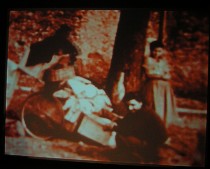 Gianikian and Lucchi use archival footage and slow it down, edit it, tint it, and add music. The final result reveals the racism of outsiders investigating and recording the native practices of Gypsies, Vietnamese (video still, left), New Caledonians and Italians in swimsuits. Well, the Italians in swimsuits video reveals more about the viewer as a male than as a racist (video still, top).
Gianikian and Lucchi use archival footage and slow it down, edit it, tint it, and add music. The final result reveals the racism of outsiders investigating and recording the native practices of Gypsies, Vietnamese (video still, left), New Caledonians and Italians in swimsuits. Well, the Italians in swimsuits video reveals more about the viewer as a male than as a racist (video still, top).
Another documentary, the Ezequiel Suarez video of an older Cuban man singing songs he composed during his retirement is a slip of a video and it seems better to me not to burden its emotional poignancy with political cant or academic jargon.
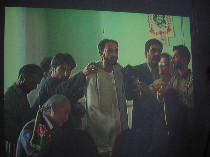 Langlands & Bell‘s Afghanistan films, taken following the U.S.-led invasion, again raise questions about the outsider’s viewpoint. When I was there, an interactive piece wasn’t yet up and running, but the other two pieces were less interesting for their intent (oh, those colonial Brits, documenting what’s going on when no one is quite sure what’s going on!)than they were for their subtext. “The House of Osama bin Laden Suite: Zardad’s Dog” seemed to once again offer native people as seen through a dissecting lens (still image, shown).
Langlands & Bell‘s Afghanistan films, taken following the U.S.-led invasion, again raise questions about the outsider’s viewpoint. When I was there, an interactive piece wasn’t yet up and running, but the other two pieces were less interesting for their intent (oh, those colonial Brits, documenting what’s going on when no one is quite sure what’s going on!)than they were for their subtext. “The House of Osama bin Laden Suite: Zardad’s Dog” seemed to once again offer native people as seen through a dissecting lens (still image, shown).
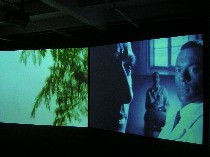 A highlight was Isaac Julien‘s “Fanon S.A.,” a shortened version of a feature documentary he had made about Franz Fanon (video still, “Fanon S.A., left). It’s full of ironic, race-related statements usually spoken by white guys, but coming out of the mouth of a super-handsome black man, phrases like “He doesn’t understand that you are as civilized as we are,” and “He’s a man just like us.” The visuals are beautiful and the content is provocative.
A highlight was Isaac Julien‘s “Fanon S.A.,” a shortened version of a feature documentary he had made about Franz Fanon (video still, “Fanon S.A., left). It’s full of ironic, race-related statements usually spoken by white guys, but coming out of the mouth of a super-handsome black man, phrases like “He doesn’t understand that you are as civilized as we are,” and “He’s a man just like us.” The visuals are beautiful and the content is provocative.
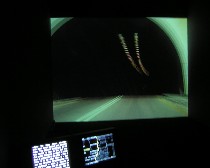 Some of the films felt like one-liners. How long does it take to get the point of a pair of films that show how irrational the swiss-cheese-style division of land is in the Middle East? Multiplicity, a multi-national collective, compared via two channels how long it takes an Israeli to make a trip and how long it takes a Palestinian to make a similar trip (the map of the trip is shown on the monitor below). The message is clear. The folly of the situation is clear. Twenty-eight minutes seems excessive (right, a still from one of the channels with monitors showing words and a map of the trip).
Some of the films felt like one-liners. How long does it take to get the point of a pair of films that show how irrational the swiss-cheese-style division of land is in the Middle East? Multiplicity, a multi-national collective, compared via two channels how long it takes an Israeli to make a trip and how long it takes a Palestinian to make a similar trip (the map of the trip is shown on the monitor below). The message is clear. The folly of the situation is clear. Twenty-eight minutes seems excessive (right, a still from one of the channels with monitors showing words and a map of the trip).
Francesco Vizzoli‘s “The End of the Human Voice” held my attention because of the wide-open, pasted-on eyes covering Vizzoli’s real eyes as he lolled in bed not listening to Bianca Jagger on the next screen, talking to him via the telephone. The allusions to French and Italian cinema might keep a cinema buff looking for the full 15 minutes, but, really, five was enough for me. I got it.
I’m not saying I didn’t enjoy these. I did. I was glad I saw them. But in the world of art video, less is more.
 Ulrike Ottinger‘s “Bild Archive” wasn’t video at all, but a series of slides (left). Again, there’s some ethnographic imagery and wonderful colors, but 40 repetitious minutes? I think not. Good news–there was a bench here.
Ulrike Ottinger‘s “Bild Archive” wasn’t video at all, but a series of slides (left). Again, there’s some ethnographic imagery and wonderful colors, but 40 repetitious minutes? I think not. Good news–there was a bench here.
 I caught a glimpse of Zarina Bhimji‘s “Out of the Blue,” (still, right) a beautiful-looking documentary of an African landscape and townscape empty of people. Bhimji was forced to leave Uganda by Idi Amin in 1972.
I caught a glimpse of Zarina Bhimji‘s “Out of the Blue,” (still, right) a beautiful-looking documentary of an African landscape and townscape empty of people. Bhimji was forced to leave Uganda by Idi Amin in 1972.
I still haven’t seen the Glenn Ligon piece or the Amar Kanwar piece.
One of the points that Nash made was these videos were not the sort of fare that a movie theater would screen.
So here they were as art in art galleries. Well, somebody has got to show these pieces and an art gallery makes sense: What other audience would put up with such discomfort–no seating; long, digressive, repetitive work?
I can see the videos working in an academic setting, perhaps. I do think the work is worth looking at and interesting, but really, video artists, including big-time, internationally known video artists, need to be more ruthless in their editing, and galleries need to make it safe and comfortable for viewers.
The Fabric Workshop has succeeded in separating the videos from one another so sound and visuals do not bleed into the next space. But the dark spaces are a problem. I did walk into a wall while I was there (it wasn’t one of the padded ones, either; leave it to me to find the only wall not covered in foam). Ow. Only a couple of spaces provided seating.
For all that discomfort, I intend to return.
In additional, a series of films will be screened at International House and University of the Arts in February. Post-screening discussions will include Julien, Gianikian and Lucchi and Kanwar. The series is being presented in auditoriums. There will be seats.









